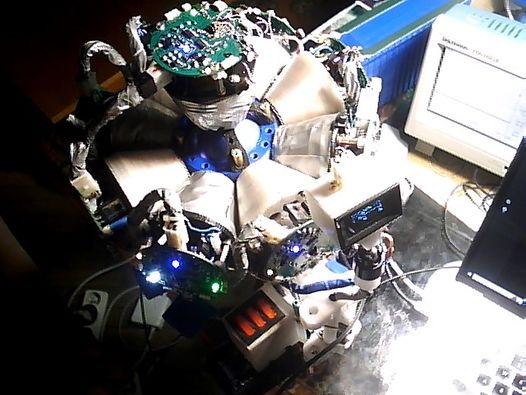
Facebook page: https://www.facebook.com/groups/280414690778573/user/100009666680494/
Inventor of Gyro_6DoF - a system in which emergent new properties arise is often called a system with emergent properties or an emergent system. Emergent properties manifest themselves in a system at higher levels of organization under certain conditions of interaction between its components, and they cannot be explained or predicted solely on the basis of a simple sum of properties of individual components. Such properties usually arise as a result of complex interactions and synergies between the elements of the system. Gyro_6DoF is three conventional gyroscopes in one, with emergent holographic properties.

A torsion balance was used by Henry Cavendish to measure the gravitational constant G. They measure the torque produced by the gravitational attraction between known masses in a state of decoherence. Gyro-6DoF is a system that creates a coherent state of solid matter and can measure rotation and displacement in all six degrees of freedom (3 axes of rotation and 3 axes of translation). When two of the three axes of the Gyro_6DoF rotor change, a jerk is produced in any of the 6 directions and a holographic inertial force (gravitational force Fgrav) arises. Fgrav = nma2 n is the order parameter (1> n> 0) the coefficient of influence of distant masses in the Universe (the Mach principle is satisfied in the coherent state of solid matter). In terms of entropic gravity, the order parameter determines the dependence of a closed system on its external environment. (Entropic gravity proposed by Eric Verlinde, which describes gravity as an entropic phenomenon associated with information and thermodynamic properties of systems on the holographic horizon). In this theory, gravity is not a fundamental force, but arises as a consequence of a statistical tendency towards increasing entropy. The order parameter n (1 > n > 0) can be used to describe the influence of distant masses in the Universe on the local physical properties of the system. In terms of entropic gravity, this parameter can characterize the degree of dependence of a closed system on its external environment. The larger the value of n, the stronger the influence of external masses on local gravitational effects and entropy behavior of the system. Thus, the parameter n serves as a measure of how much a system in a coherent state of solid matter is influenced by other masses in the Universe, maintaining a connection with Mach's principle in the context of entropic gravity. m- mass of the rotor a2 - jerk (the first derivative of acceleration resulting from coherent oscillations of the rotor in a vacuum and displacement of the inertial mass around the center of acceleration).
Experimental setup. We need to hang the Gyro-6DoF working device on a torsion scale. This will make it possible to measure minute changes in torque caused by distant gravitational interactions.
Measuring the order parameter n. Gyro-6DoF will be used to accurately measure the device's position in space and any changes caused by external long-range gravitational influences. The parameter n is defined as the degree of influence of distant masses (distribution of mass information on the distant holographic horizon (holographic principle)) on the local gravitational field. According to Mach's principle, interaction with distant stars should manifest itself as independence of the device's position in space and a change in the balance of the scales. This can be recorded by observing the behavior of the system on a torsion balance.
Changing the balance: The balance of the scale will depend on the position of the device in the main planes (for example, XY, XZ, YZ). By measuring changes in these planes, it is possible to estimate the influence of the removed masses and calculate the parameter n. Hanging the working gyroscopic system Gyro-6DoF on a torsion balance and taking measurements can provide information about the order parameter n and how remote masses (according to Mach's principle) affect the local gravitational system. This method will allow us to study the dependence of position in space and changes in the balance of weights in response to remote external gravitational influences on solid matter in a coherent state. Gyro-6DoF, with its ability to measure total rotation and create total inertial mass, could become a key tool for studying the coherent state of matter and dark physics. It could help explain why the inertial mass of stars on the periphery of galaxies increases and shed light on the nature of dark matter and other unknown aspects of the Universe. https://arxiv.org/pdf/1001.0785
10/17/24 - I am working on a device Gyro_6DoF, which is already functioning, although in a limited form. The rotor in the device successfully levitates, rotates and creates a vacuum inside the stator cavity, and the angular velocity of rotation is 6000 cycles per minute. However, since the rotor is made of plastic, when trying to create three-dimensional speed, centrifugal forces destroy the structure, which led to an explosion in the spring of this year. To avoid such problems, a solid neodymium multi-pole magnet is needed, as well as a stator housing made of non-ferrous non-magnetic metal. At the moment, I have acquired a two-inch neodymium ball magnet, but it is bipolar. For further work, equipment is required that will allow you to re-magnetize the rotor to achieve the desired configuration of a multi-pole magnet. The prototyping process is complex, and a professional approach is required to avoid further delays. Without the necessary resources and precise equipment, work on the project is delayed, although the potential of the device is obvious. Given the complexity of the design and the high precision required for implementation, professional prototyping assistance is essential to successfully complete the development.
11/7/24 - The conversion of zero-point energy (ZPE) into electrical power requires a device capable of interacting with the vacuum structure itself. The fundamental device, unlike traditional methods, solves many theoretical and practical problems at once, as well as interacts with the deep aspects of the quantum vacuum. There is no other way to efficiently convert ZPE into electricity, since the algorithm and design of such a device are strictly defined. Gyro_6DoF is not just a mechanical device, but a concept based on physical principles such as the Mach principle and the holographic principle. These principles require compliance with standard engineering connections and link the principles to fundamental laws of nature, which requires a new level of scientific understanding. The information about Gyro_6DoF is freely distributed and has already been published, which makes it ineligible for patenting since patent law is based on novelty and uniqueness. Publishing concepts in the public domain not only limits patentability but also complies with the philosophy of open science. Ideas that can change our understanding of physics and important energy issues should be available for everyone to explore and develop. This philosophy makes a compelling argument: fundamental discoveries like the ZPE transformation are better viewed as contributions to science rather than as potential commercial technologies that can be secured by a single patent holder.
I respect all authors working in the field of energy conversion, however, I draw your attention to the fact that a working device must necessarily be fundamental. Fundamental devices are distinguished by their operating principles being based on deep physical laws that can encompass several key aspects of the universe. They are not limited to solving a single problem but have the potential to demonstrate a multitude of interconnected effects that underlie the structure of reality. Gyro_6DoF is an example of this approach, as its design allows it to go beyond traditional energy conversion mechanisms.
A working device must be fundamental, as its effectiveness and significance depend on the ability to not only convert energy but also to demonstrate control over fundamental forces of nature. The ability to control gravity, for example, opens the way to using inertial mass to create antigravity effects. This ability undermines established principles of mechanics and proves that the device operates at a deeper level of interaction with the physical world.
Time dilation is another key aspect. Demonstrating this effect in a device means that it not only converts energy but also affects the flow of time, linking it to spatial characteristics. This creates conditions for the development of technologies that will change our understanding of time as a linear and irreversible quantity. The time machine ceases to be a fantasy, turning into a practical task.
Teleportation of physical objects, as well as instantaneous exchange of information without the speed of light limitations, are manifestations of quantum effects and interactions at a level that exceeds traditional physical limitations. A device that demonstrates such effects shows that it interacts with the very essence of quantum reality, which makes it not just an energy converter, but a tool for exploring and manipulating reality at a fundamental level.
Approaches using mercury, electric motors, wheels, or water bottles are unable to go beyond engineering solutions. They are mechanical devices that try to adapt known technologies to new problems, ignoring the need to revise the basic principles. This approach is reminiscent of medieval attempts to explain the world through primitive designs, unaware of the existence of fundamental physical laws.
In contrast, a fundamental device must rely on laws that not only explain its operation, but also open up new horizons for science. This includes interacting with zero-point energy, manipulating the properties of space-time, and realizing effects that conventional physics considers impossible. Without these properties, the device cannot claim to be fundamental, meaning its potential will remain limited by outdated technology. [1/15/25]
See Also
cycloid-space-curve-motion
Emergent properties
Figure 10.05 - Three Orthogonal Planes where Six Gyroscopic Vortices Converge
Figure 3.21 - Vortex or Gyroscopic Motions as Conflicts or Antagonisms between Light and Dark
Figure 3.22 - Vortex or Gyroscopic Motions as Conflicts or Antagonisms between Light and Dark Zones
Figure 3.23 - Vortex or Gyroscopic Motions as Conflicts or Antagonisms between Light and Dark Zones
Figure 3.28 - Compression and Expansion Forces in Gyroscopic Motions
Figure 3.30 - Discrete Degrees or Steps in Gyroscopic Compression Motion
Figure 4.5 - Compound Gyroscopic or Vortex Motions
Figure 5.3 - Vortex or Gyroscopic Motion is Natural and occurs ubiquitously
Figure 5.4 - Vortex and Gyroscopic Motion on One Plane then on three forming Sphere
gyrocar
gyrokinetics
gyroscope
gyroscopic principle
Gyroscopic Reactionless Drive
Levitating Gyroscopes
New Concept - Wobbling Gyroscopes Seek Balance
New Concept - XXXI - Introducing the Gyroscope into the Octave Wave
New Concept - XXXII - The Nucleus is the Hub of the Gyroscope Wheel
New Concept - XXXVI - Wobbling Gyroscopes Seek Balance
Polarity Controlled Electric Gyroscope
universal gyroscope
Universal Triune Spirals and Motions
